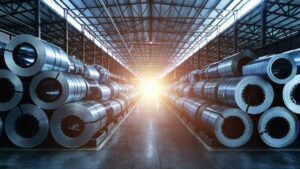Demand for high grade iron ore is stronger than ever and these three plays are positioned to benefit

Pic: John W Banagan / Stone via Getty Images
Hold your horses, say the folks at Goldman Sachs and head of base metals and bulks research Nicholas Snowdon of “copper is the new oil” fame.
Snowdon told delegates at last week’s Singapore Iron Ore Forum it will not be until 2023 when we see more normalisation in the market.
The twin pillars of supply constraints and peaking Chinese steel demand on which iron ore’s wild ride to US$220/t have been based are still standing, Snowdon said.
“It would be wrong to say that the bull market for iron ore, you know, is on the cusp of ending,” Snowdon said.
“When you look forward over the next two, three years, supply growth rates will actually decelerate … from where they stand today.
“There is not an imminent risk of major supply response in the iron ore market and that’s very key to the … outlook for price.”
A bear market traditionally kicks in when prices fall 20% from their peak, which for iron ore was over US$230/t on May 12.
The world’s biggest customer China has made attempts to “jawbone” down prices since then with only fleeting success.
Supply not emerging to put the screws on prices: analyst
Peloton Capital resource analyst Ian Spence has worked in the iron ore and steel industries for decades.
He concurs that the dynamics required for downward price shifts forecast by some analysts as soon as the end of this year are unlikely.
“I’m of the view that I don’t believe it’s going to be sustained where it is,” he said.
“(But) I don’t think they’ll dramatically come off because I don’t see the likes of Vale in Brazil for example immediately ramping up production really fast.
“The likes of Africa, we’re not really seeing a lot of things coming out of Africa in terms of projects getting off the ground.
“I think it’s some way off, so I think the iron price is going to be considerable for the time being.”
On the demand side of the equation, Spence said steel demand was still strong, with growth likely to emerge outside of China as Western economies push ahead with major infrastructure projects.
Grade premiums an important consideration
Spence favours magnetite producers and project developers who promise to produce a premium high grade iron ore concentrate.
As prices decline product grades will be key to profitability because of the steep premiums high grade fines, lump and concentrate now garner.
The overall grade of iron ore from the majors has been slipping, and some products both in production and in the pipeline are so pure they would generate an higher premium even than the 65% index reserved for Vale’s high grade Brazilian ore.
These products require less coking coal and energy in the steelmaking process, making them favourable for steelmakers looking to hedge against rising coal prices and comply with anti-pollution policies from national and local authorities.
“In the future, particularly for magnetite players, it’s almost not good enough now to produce a 62% concentrate,” Spence told Stockhead.
“You’ll need to produce a premium or super premium concentrate, super premium being 67.5-68.5% iron.
“If we are to see iron ore prices start to decline … what steel mills are going to start looking for is the premium products.
“At the other end of the spectrum, at less than 60%, you may start to see some of those struggle a little bit first if prices were to come off.
“I personally don’t think you’re going to see it come off (dramatically), it may come down with a bit of a softer landing.”
Spence said iron ore miners who can prove their product is “green” and reduce emissions in the mining process would also become premium suppliers for steelmakers who want to reduce ESG risk in their supply chain.
Who is promising a high grade premium?
If that is the case, which companies happen to fit the bill? Spence has three picks – a miner, a near term developer and a longer term play – who he believes can deliver the grades required to meet the iron ore demand of the future.
CHAMPION IRON (ASX:CIA)
Michael O’Keeffe’s Champion Iron owns the 7.5mtpa Bloom Lake operations in Canada, which produce a high grade iron ore concentrate at around 66.5% Fe.
According to its latest quarterly, lab testing is being undertaken to deliver a 69%+ product.
“There’s a bit of upside potential to be had in Champion Iron for sure,” Spence said.
“It wouldn’t faze me if that share price started approaching the $9-10 mark.
“Champion do produce very good high quality product, which is in demand.”
A big focus, Spence said, would be on its Phase 2 ramp up, which will double Bloom Lake’s capacity to 15Mtpa from mid-2022.
It also has a natural advantage in the availability of local hydroelectric power to provide clean energy for the project.
MAGNUM MINING & EXPLORATION (ASX:MGU)
Magnum Mining and Exploration bought the Buena Vista iron project in Nevada in October last year and is already trying to engineer a DSO starter operation to capitalise on high prices.
More than 3Mt of magnetite has already been sold over Buena Vista’s life, dating back to when Japan was the key export market for iron ore.
“What I get very excited about with this one is it’s an iron project that’s been known since the 50s and 60s,” Spence said.
“It’s had a lot of drilling done on it and in the 60s the Japanese were taking product from there, magnetite concentrate product and it’s well known to the Japanese.”
Magnum’s first phase would see it ship 62-65% ore via an offtake and prepayment deal with global major Anglo American before moving on to a larger stage 2 operation selling 68% magnetite concentrate from a wet beneficiation plant. They have plans to go further downstream as well.
“Phase 3 they’re looking at producing a hot briquetted iron or pig iron by developing a pig iron plant on that West Coast of the United States,” Spence said.
“That’s very exciting because they’re potentially going to use a biomass.”
MAGNETITE MINES (ASX:MGT)
Magnetite Mines has been one of the top performing stocks on the ASX over the past 12 months, and while it has pulled back since releasing a PFS a couple of weeks ago, it remains 340% up year to date.
The junior owns the Razorback magnetite project in South Australia which would produce 2.7 million tonnes per annum of high-grade concentrate over an initial mine life of 23 years at a capital cost of US$429-506 million.
That is around a third of the $1.5b-plus price tag a study by previous management in 2013 showed the project would carry to enter production.
Some of the capital and operating cost reduction will be found from leveraging cheap wind energy available on the SA grid rather than producing power on site.
“This is a great example of different management coming at things quite differently,” Spence said. “The previous management were not really looking at the existing infrastructure that’s around the project.
“They were looking at producing power on site, bigger production, a slurry pipeline to the coast and building its own port.
“In this new PFS they’ve looked at existing infrastructure … believe it or not there’s quite a lot of infrastructure in that area.
“Not only is there power from the grid, but much of it’s renewable, and not only are they looking at producing less but it’s high quality – you’re looking at a super premium concentrate.”
The views, information, or opinions expressed in the interviews in this article are solely those of the interviewees and do not represent the views of Stockhead. Stockhead does not provide, endorse or otherwise assume responsibility for any financial product advice contained in this article.
Related Topics
UNLOCK INSIGHTS
Discover the untold stories of emerging ASX stocks.
Daily news and expert analysis, it's free to subscribe.
By proceeding, you confirm you understand that we handle personal information in accordance with our Privacy Policy.








